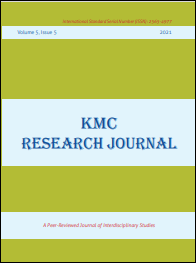Community Forestry and Local Development A Study of Sukhani Community Forest User Group
DOI:
https://doi.org/10.3126/kmcrj.v5i5.53578Keywords:
community forestry, people’s participation, socio-economic factors, local resources, local developmentAbstract
Community forestry is small scale, village level forestry practice where decisions and actions are often made on a collective basis, and where the rural population participate in planning, establishment, management and harvesting of forest crops and receive a many or proportion of the socio- economic and ecological benefits from the forests. Conceptually community forestry can range from pure forest cropping on one extreme to combining tree and food crops agro forestry on the other. In the context of Nepal, according to forest survey, 2016, forest area had covered 44.74 of the total area of the country. This proves the popularly known proverb “Hariyo Ban Nepal Ko Dhan”. Forest alone contributes 10 percent of total GDP; livestock get 40 percent of total fodder from forest foliage. Fuel wood contributes about 76 percent of the total energy sources used in the country, which also comes from forest. Also, much of the agricultural system are directly or indirectly based on the forest. Community Forestry was introduced in Nepal in 1978. The community forest has been defined as the control, protection and management of the local communities known as user groups. It advocates strong community participation, bottom-up planning and sustainable use of forest resources. The main objective of the CF is to achieve the sustainable forest resources by converting accessible national forest into community forest into in stages. The CF approach has been highly successful in the protection of the forest in the hills of Nepal. The local user groups are responsible for the control, protection and management of the forest. CF advocates strong community participation, bottom-up planning and sustainable use of forest resources. Under this program, 2,312,545 hectares of forest land have been handed over to the community, up to 22,519 user groups, and 21,00,000 HHs were directly benefitted in mid-July, 2020. It shows that after emergence of community forestry program, local developmental activities have been increased.
Downloads
Downloads
Published
How to Cite
Issue
Section
License
© Koteshwor Multiple Campus




